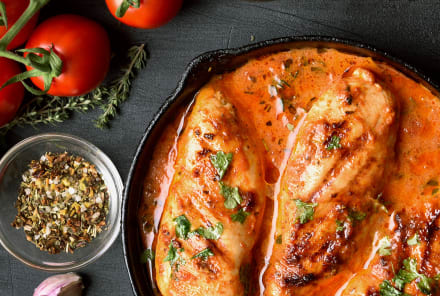Advertisement
Here's How Long It Actually Takes To Heal Inflammation

Inflammation underscores so much of what we cover here at mbg—it’s the root cause of not only preventable diseases but also gut dysfunction that many of us experience daily. So, for the next 10 days, we’re doing a deep dive into inflammation, giving you everything you need to know: the basics of what inflammation is, how to know if you have it, and what you can do to control it. Follow along here, and to learn even more, check out our FREE Functional Nutrition Webinar with Vincent Pedre, M.D.
Almost every patient I see has some degree of chronic inflammation. That's especially concerning since chronic inflammation is a chief driver for nearly every disease1 on the planet, including obesity. It contributes to numerous gut problems including dysbiosis2, or gut imbalances that lead to problems like leaky gut.
Sometimes finding the sources of chronic inflammation can take some detective work. For one patient, we discovered that hidden black mold in her house from an old leak was creating it. Others may work in factories, where their occupational exposures can exacerbate inflammation.
Yet for almost everyone, inflammation stems from multiple culprits, including poor diets, the overprescribing of antibiotics, chronic stress, insufficient sleep, and environmental exposures.
The good news is that, with the right strategies, you can start healing your gut and heal your body of inflammation, pain, and other miseries.
Chronic inflammation doesn't happen overnight, nor does reversing it, especially if you've been very inflamed for a long time. But by incorporating all (not just one—remember, there's no easy way out!) of these strategies, you will begin taming your inflammation and start seeing results in as little as two weeks.
Once you've healed, you'll notice the symptoms that were nagging you, like unexplained fatigue and mental fog, will have disappeared or become unnoticeable. In my practice, I've found that calming down the immune system and chronic inflammation can take approximately four weeks. If you have a long-standing health condition like an autoimmune disease, full healing usually takes anywhere between three and six months or longer. Be patient with yourself because healing is never continuous—it happens in what I call "the quantum steps of healing." You may feel no progress has been made, then all of a sudden, three months in, you'll experience a sudden improvement in all of your symptoms. Dedication without expectations is the key to healing.
You'll begin taming your inflammation and start seeing results in as little as two weeks.
Once you've healed, keeping up with a strict plan may be burdensome, but I encourage you to hold on for a little bit longer. As a rule of thumb, stick with the plan for another two to three months after you feel your best. At that point, you can experiment with an occasional cheat, but keep a journal of what you're eating and how you're feeling to make sure your symptoms don't start creeping back in. If you don't want to end up back where you started, treat your body with care and respect.
Try following these seven simple healing practices, and note how quickly you notice changes in your own body:
1. Focus on your diet.
Taming chronic inflammation starts with what you put on the end of your fork. In other words, your best defense to fight inflammation starts with your very next meal or snack. Researchers find that a pro-inflammatory diet significantly increases weight gain3 and your risk for being overweight or obesity.
The best way to shift that balance is to eat fewer inflammatory foods and much more anti-inflammatory food. The latter include wild-caught fish, loads of nonstarchy vegetables, low-sugar fruit like berries and avocado, raw nuts and seeds, and cultured and fermented foods. Stop and consider, for instance, that our ancestors ate nearly an equal ratio of omega-3 and omega-6 fatty acids—whereas today we are eating 20 times (sometimes higher)4 of inflammatory omega-6 fatty acids. We're eating fewer anti-inflammatory foods, but the inflammatory ones we consume (sometimes from not-so-obvious sources like almond milk or factory-raised eggs) can crowd out the healthy ones.
Take soybean oil, prevalent in pretty much any restaurant you eat, which can decrease the amounts5 of the anti-inflammatory fatty acids EPA and DHA. Even if you're avoiding the usual suspects like sugar, gluten, and other high-sensitivity foods I often talk about, inflammatory foods can be slipping into your diet. Grain-fed meats, vegetable oils, roasted nuts and seeds, and pretty much any processed food in your grocery store fuels inflammation.
2. Heal your gut.
You cannot fix inflammation without fixing the gut. When your gut lining is disturbed, it cannot absorb nutrients optimally and inflammation develops. Eventually problems like leaky gut lead to food sensitivities and even autoimmune disease.
A downward spiral occurs as gut inflammation becomes systemic (or full-body) inflammation, creating pain, headaches, and other symptoms that you might never suspect originated in your gut.
Healing gut inflammation requires time and patience. The right protocol eliminates food sensitivities, incorporates plenty of anti-inflammatory foods, and includes gut-supporting nutrients like L-glutamine, probiotics, and prebiotics. Here's a three-day plan to get you started.
3. Get the right nutrients.
If you're not eating an anti-inflammatory diet and incorporating other lifestyle strategies delineated here, taking supplements that can lower inflammation won't help much.
But combined with the right diet, supplements can help tame inflammation. Among the favorites I use in my practice daily are:
- Curcumin: Turmeric is that beautiful yellow-orange spice, but its main claim to fame is curcumin, which provides anti-inflammatory6, antioxidant, and gut-healing benefits. Sprinkle organic turmeric powder onto all your food, but to get the full anti-inflammatory benefits, consider a concentrated curcumin supplement.
- Fish oil: The two main, anti-inflammatory omega-3 fatty acids, EPA (eicosapentaenoic acid) and DHA (docosahexaenoic acid), are important anti-inflammatory promoters in the body that are often deficient in the American diet. Studies have shown that these omega-3s help reduce inflammation7 in the gut and elsewhere. Make sure you source the right type. I only recommend practitioner-grade supplements.
- Probiotics: These healthy microorganisms support optimal gut-flora balance, but evidence shows they can also reduce inflammation8. It's always best to source a high-potency probiotic from a reputable company that focuses on gut health. Read my guide to choosing probiotics here.
4. Avoid environmental toxins.
Many of the over 80,000 chemicals we are exposed to daily have not been tested for human safety. They are everywhere: in our furniture as fire retardants, in cosmetics as heavy metals, in our household cleaners as emulsifiers, and in our food as preservatives. These toxins create all sorts of problems9. They disrupt our hormonal balance, keep our immune system revved up, and increase our risk for diseases including cancer and autoimmune disease. Chronic inflammation plays a role in all of these problems.
Just like we are all inflamed, we are all toxic. To reduce that toxic load, you'll want to minimize the toxins you're exposed to daily that are under your control.
That might mean becoming more mindful about what cosmetics you use, what household cleaners you keep around, and what skin products you spread on your body, as well as drinking clean, filtered water, eating mostly organic plant foods, and if you are a meat eater, mainly consuming clean protein sources like pasture-raised meats.
You'll also want to eat plenty of detoxifying foods, including leafy and cruciferous greens, along with spices like turmeric. Once or twice a year, consider working with a professional to incorporate a plan that provides your cells the nutrients they require to optimize detoxification. And a gut cleanse is a great way to clean out the pipes and dump some of those accumulated toxins.
5. Move your body.
Research shows that regular exercise protects against chronic low-grade systemic inflammation10 present in diseases, such as type 2 diabetes and cardiovascular disease. I like to use the word "movement" as opposed to "exercise" because movement encompasses a broader array of activities.
Yours might include yoga, brisk walking, or weight resistance exercises. Research shows high-intensity interval training, which is fast and effective, can reduce the inflammation that contributes to disease like cancer11. But remember this—if you're a CrossFitter or do any high-intensity exercise, then stock up on the anti-inflammatory nutrients I mentioned above. Moderate exercise reduces inflammation, but extreme exercise (like marathon training and Tough Mudders) will increase inflammation.
The important thing is that you do something that challenges your body without abusing its limits.
6. Manage your stress.
Stress is a major and underestimated factor that affects inflammation, even when all other lifestyle behaviors (like diet and exercise) are on point.
Stress increases inflammation12, regardless of how good you're being with your diet. It activates the fight-or-flight response that makes you feel like you're under attack when you're not. It can lead to elevated blood pressure, palpitations, and reduced blood flow to the intestines, resulting in poor digestion and assimilation of nutrients.
Some of my patients live under and handle such elevated levels of stress on a daily basis they consider it normal. They have become desensitized to the thought of stress, but their bodies have not been desensitized to the ravages of stress. Essentially, they've ceased to notice what a huge impact stress has on their lives. I often point out to my patients how full their plates are and how even if the load they carry (between work and social life) feels "normal," it shouldn't be their "normal."
Start by saying "no" and creating more space in your life for rest and relaxation.
7. Sleep more.
Forty percent of Americans get less than the seven hours of recommended sleep per night. When compared to the amount of sleep Americans got in 1942, we are getting one hour less per night. That's outstanding considering modern technology should be making our lives easier, not harder. The problem is the health ramifications of sleep deprivation.
Studies support what I see regularly in my practice: Sleep deprivation can trigger or exacerbate inflammation13. Multiple mechanisms are at work here. Sleep loss adversely alters the body's inflammatory markers, but then you are more prone to make unwise food choices, fuel up on caffeine to get through the morning, and feel more stressed throughout your day with less sleep. Keeping inflammation under control requires eight to nine hours of solid, uninterrupted sleep every night.
Sleep hygiene is important. At least one hour before bedtime, shut down your electronics, block out sleep-disrupting blue light by putting on your blue-spectrum-blocking glasses, dim the lights, and pull up a good book to read (on paper).

Dr. Vincent M. Pedre, medical director of Pedre Integrative Health and president of Dr. Pedre Wellness, is a board-certified internist in private practice in New York City since 2004. His philosophy and practices are a blend of both Western and Eastern medical traditions. He is a clinical instructor in medicine at the Mount Sinai School of Medicine and is certified in yoga and medical acupuncture. His unique methodology is best described as integrative or defined by a functional, systems-based approach to health. With his holistic understanding of both sides of the equation, he can help each patient choose the best course of action for their ailments to provide both immediate and long-term relief. His holistic approach incorporates positive, preventive health and wellness lifestyle choices. Dr. Pedre Wellness is a growing wellness platform offering health-enhancing programs along with informative social media and lifestyle products, such as dietary supplements, books, and weight-loss programs.

Dr. Vincent M. Pedre, medical director of Pedre Integrative Health and president of Dr. Pedre Wellness, is a board-certified internist in private practice in New York City since 2004. His philosophy and practices are a blend of both Western and Eastern medical traditions. He is a clinical instructor in medicine at the Mount Sinai School of Medicine and is certified in yoga and medical acupuncture. His unique methodology is best described as integrative or defined by a functional, systems-based approach to health. With his holistic understanding of both sides of the equation, he can help each patient choose the best course of action for their ailments to provide both immediate and long-term relief. His holistic approach incorporates positive, preventive health and wellness lifestyle choices. Dr. Pedre Wellness is a growing wellness platform offering health-enhancing programs along with informative social media and lifestyle products, such as dietary supplements, books, and weight-loss programs.
13 Sources
- https://www.ncbi.nlm.nih.gov/pmc/articles/PMC3492709/
- https://www.ncbi.nlm.nih.gov/pmc/articles/PMC5512975/
- https://www.ncbi.nlm.nih.gov/pubmed/28544794
- https://www.ncbi.nlm.nih.gov/pubmed/26950145
- https://www.ncbi.nlm.nih.gov/pmc/articles/PMC3076650/
- https://www.ncbi.nlm.nih.gov/pubmed/17569207
- https://www.ncbi.nlm.nih.gov/pubmed/16531187
- https://www.ncbi.nlm.nih.gov/pmc/articles/PMC5490534/
- https://www.ncbi.nlm.nih.gov/pmc/articles/PMC4492068/
- https://www.ncbi.nlm.nih.gov/pubmed/15772055
- https://www.ncbi.nlm.nih.gov/pubmed/29164363
- https://www.ncbi.nlm.nih.gov/pmc/articles/PMC5476783/
- https://www.ncbi.nlm.nih.gov/pmc/articles/PMC3548567/
Watch Next
Enjoy some of our favorite clips from classes
Enjoy some of our favorite clips from classes
What Is Meditation?
Mindfulness/Spirituality | Light Watkins
Box Breathing
Mindfulness/Spirituality | Gwen Dittmar
What Breathwork Can Address
Mindfulness/Spirituality | Gwen Dittmar
The 8 Limbs of Yoga - What is Asana?
Yoga | Caley Alyssa
Two Standing Postures to Open Up Tight Hips
Yoga | Caley Alyssa
How Plants Can Optimize Athletic Performance
Nutrition | Rich Roll
What to Eat Before a Workout
Nutrition | Rich Roll
How Ayurveda Helps Us Navigate Modern Life
Nutrition | Sahara Rose
Messages About Love & Relationships
Love & Relationships | Esther Perel
Love Languages
Love & Relationships | Esther Perel












